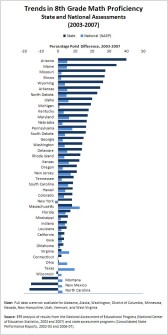The No Child Left Behind Act calls for all students to achieve proficiency in reading and math by the 2013-14 school year. Although data from state testing programs show increasing proportions of students reaching or surpassing the proficiency bar, some experts question the validity of such gains. Those results have raised eyebrows, in part, because trend lines are rising much more rapidly on state-developed tests than on the U.S. Department of Education’s National Assessment of Educational Progress (NAEP), also known as The Nation’s Report Card. To explore this issue, the EPE Research Center performed an analysis comparing trends on NAEP and state-developed assessments between 2003 and 2007. Data were available for 42 states. In 16 states, gains in the percent of students reaching proficiency in 8th grade math were at least ten percentage points greater on their state-developed assessments than on NAEP. Overall, about 80 percent of states experienced a faster growth rate on their state tests, while only eight states had larger gains on NAEP than on state assessments.
For more state-by-state data on state assessments and other topics, search the EPE Research Center’s Education Counts database.



